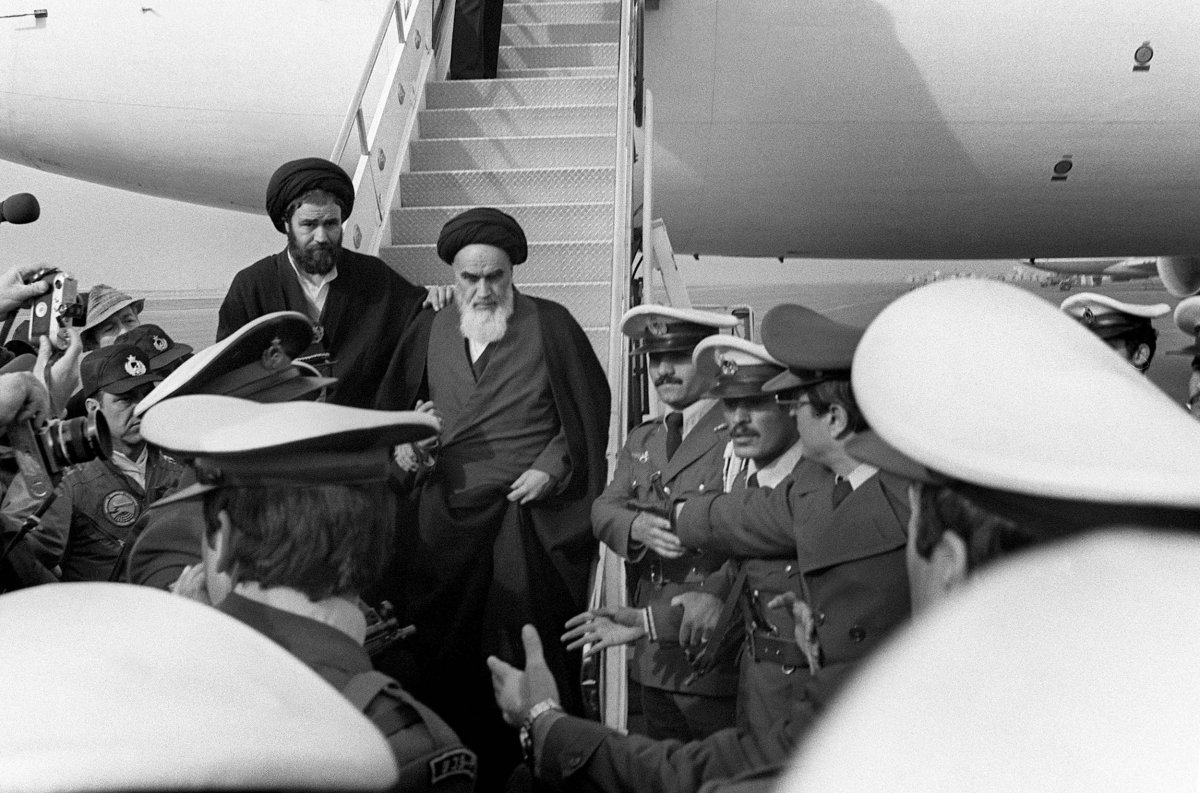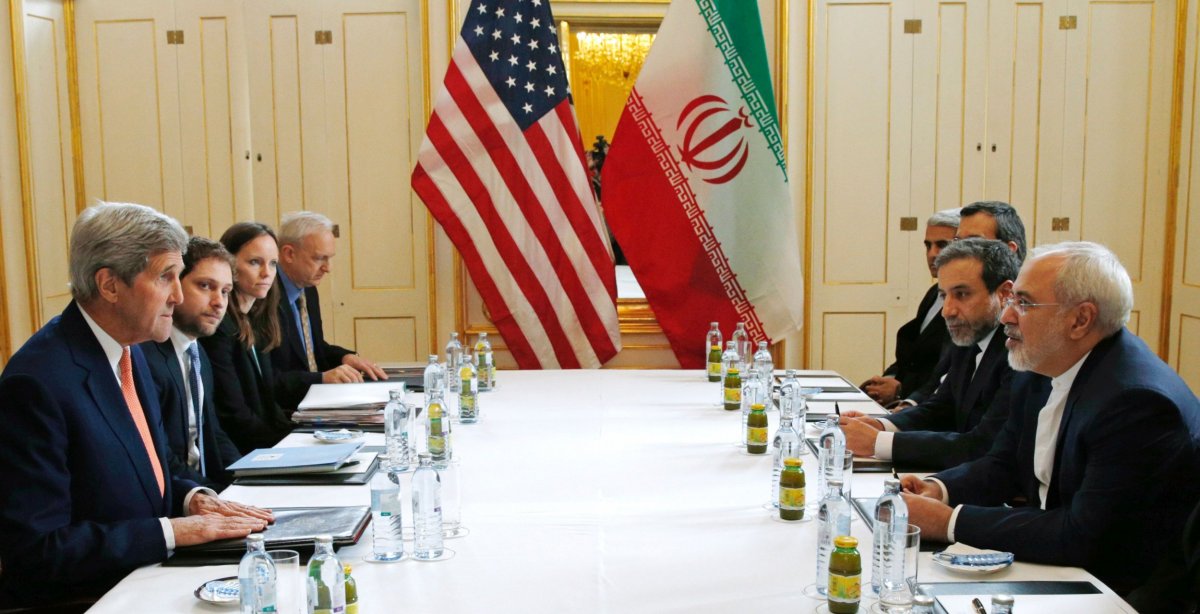
Iran's leadership has blamed foreign powers, especially the U.S., for having a hand in recent, deadly protests that have swept the country, pointing to President Donald Trump's immediate support for demonstrators on social media and the U.S.'s long history of invasions and interventions that includes an early interference into Iranian politics that shaped the modern relationship between the two nations.
As Iranian Foreign Ministry spokesperson Bahram Qasemi blasted Trump's eager backing of Iranians taking to the street to protest economic conditions and strict religious rule, Iran's supreme leader and top authority, Shiite Muslim cleric Ayatollah Ali Khamenei, commented on the situation for the first time Tuesday. Khamenei warned of foreign meddling behind the country's civil unrest, but maintained that "what prevents the enemies and their hostile actions is the spirit of courage, self-sacrifice and faith among the people."
Related: Iran tells Trump to fight U.S. crime and poverty, not other countries on Twitter
"In recent events, the enemies of Iran united by using different tools in their disposition, including money, weapons, politics and intelligence, in order to create problems for the Islamic system," Khamenei said, according to a statement posted to his official website.
Iranian President Hassan Rouhani also noted the day before that there were "enemies of the Islamic Republic of Iran" trying to destabilize the country, but the reformist moderate leader said the threat could be "converted into an opportunity" to address national grievances "because all the people on the streets are not those commanded by foreigners and there are some of them who are protesting for their own feelings and problems," Iran's semi-official Mehr News Agency reported.
Iran's expanding foothold across the Middle East has been met with three leading opponents: Israel, Saudi Arabia and the U.S. Iran's support for an independent Palestinian state and militant groups opposed to Israel has led Israeli Prime Minister Benjamin Netanyahu to label Iran public enemy number one and the two countries routinely accuse the other of warmongering and funding terrorism. Similar charges are exchanged between Iran and conservative Sunni Muslim kingdom Saudi Arabia. The two have backed opposing militant and political movements across the region, engaging in proxy wars of influence.
While both Israel and Saudi Arabia have frequently found themselves the target of Iran's political rhetoric, the pair's mutual ally has an even longer, arguably more controversial history with modern-day Iran.
At the end of World War II, a joint invasion by the U.K. and the Soviet Union removed Iranian monarch Reza Shah Pahlavi and replaced him with his son, Mohammad Reza Pahlavi. The younger Pahlavi enjoyed Western backing, which proved useful for him when popular, democratically elected Iranian Prime Minister Mohammad Mossadegh threatened the Shah's absolute power. Mossadegh passed laws limiting Pahlavi's control and nationalized the oil industry, in which the U.K. had heavily invested. Viewing this as a threat to its interests, the U.K. reached out to the CIA for help.
In August 1953, the CIA and U.K. intelligence orchestrated a pro-Shah coup against Mossadegh, removing him and reinstalling Pahlavi as the unchallenged head of the country. Pahlavi would go on to rule as shah for more than 25 years, accused of various human rights abuses, until he himself was forced to flee during the 1979 Islamic Revolution that shaped the country's contemporary political system. Iran's Shiite Muslim clergy ultimately consolidated power, placing the influential Ayatollah Ruhollah Khomeini at the helm and ending 2,500 years of the Persian Shah monarchy.

Caught up in the chaos of the revolution were dozens of U.S. diplomats and citizens in Washington's embassy in Tehran. Iranian student activists stormed the building and held 52 of its occupants hostage as revenge for the U.S. refusing to extradite Pahlavi, who had traveled to the U.S. to be treated for cancer. The 444-day hostage crisis, believed to be the longest of its kind in modern history, was resolved through extensive negotiation and hostages were released on the inaugural day of President Ronald Reagan, January 20, 1981.
Throughout the crisis, however, Iran was hit by the first of what would be decades of U.S.-led economic sanctions as well as an invasion by neighboring Iraq. The U.S. favored Iraq throughout the roughly eight-year conflict, but also supplied arms to Iran via Israel as part of a covert arrangement in 1985 to release U.S. hostages allegedly held by Iran-backed Shiite Muslim militant group Hezbollah in civil war-torn Lebanon. The money was diverted to fund anti-communist Contra guerrillas in Nicaragua and, when the news leaked, the scandal became known as the Iran-Contra Affair.
On July 3, 1988, amid high tensions and confrontations with Iranian military speedboats in the Strait of Hormuz, U.S. Navy guided missile cruiser USS Vincennes shot down Iran Air Flight 655 traveling over Iranian airspace from Mehrabad, Iran, to Dubai, United Arab Emirates, apparently mistaking the civilian Airbus A300 B2-203 for an F-14A Tomcat fighter. All 290 people on board were killed. A joint Newsweek and ABC Nightline investigation published in 1992 found the U.S. warship had entered Iranian waters, a violation of international law.
Following the 9/11 attacks in 2001, the U.S. and Iran actually coordinated in Afghanistan to defeat the Taliban Islamist militant group, which had refused to give up Al-Qaeda leader Osama bin Laden following the world's deadliest act of terror. At the same time, however, Iran was included in President George W. Bush's "Axis of Evil" speech in 2002 along with North Korea and Iraq, which the administration proceeded to invade the following year.
The majority-Shiite Muslim government that replaced Hussein in Iraq opened up to Iran and, after the war against the Islamic State militant group (ISIS) came in 2013 and 2014, Iran and the U.S. again found themselves on the same side. Forces backed by the U.S. and Iran separately fought ISIS in Syria too, but differed over the fate of Syrian President Bashar al-Assad, a longtime Iranian and Russian ally that the U.S. has sought to oust since the outbreak of a 2011 uprising against his government.

A historic breakthrough in U.S.-Iran relations occurred in September 2013 when Rouhani announced via Twitter that he had spoken with President Barack Obama about resolving the nuclear issue that had plagued Iran's relations with the West for the past decade. In July 2015, Obama and Rouhani, along with China, France, Germany, Russia and the U.K., reached an agreement that would see the U.S. gradually roll back sanctions against Iran in exchange for Tehran cutting its nuclear production. In both countries, the agreement was widely celebrated, but also opposed by hardliners.
On the campaign trail, then-Republican presidential hopeful Trump frequently targeted the deal and vowed to renegotiate its terms or scrap it altogether as he entered office in January. Despite the International Atomic Energy Agency and the State Department finding Iran to be in compliance with the agreement, Trump decertified the deal in October and promised a more militant approach to isolate Iran and rein in its actions abroad, including its alleged support for terrorism.
Talk of Iranian regime change among Trump's top officials, including Secretary of Defense James Mattis and Secretary of State Rex Tillerson, and similarities between the Trump administration's rhetoric on Iran and the Bush administration's strategy toward Iraq leading up to the invasion in 2003 have prompted Iranian threats of retaliation should it feel provoked. These tensions have been exacerbated as waves of protests hit the country and voices such as Pahlavi's son entered the narrative.
"Do not be fooled by the regime's claims that the #IranProtests are being supported and funded by outside groups. That is a lie—and one the regime invents every time it feels threatened. This uprising is real, it is happening, and it is 100% Iranian," Reza Pahlavi tweeted Tuesday.

The Trump administration has taken advantage of the unrest to back up its portrayal of the Iranian government as a "rogue regime" and "evil dictatorship" not supported by most Iranian people. Amid reports that Iran had blocked access to certain websites, the State Department has used its Farsi-language Twitter and Facebook accounts to communicate with and offer support for protesters, despite warnings from Iran and other countries, such as Russia, not to get involved.
Last month, U.S. ambassador to the U.N. Nikki Haley presented what she called "indisputable" evidence that Iran had supplied a ballistic missile fired in November by Yemeni Zaidi Shiite Muslim rebels known as the Houthis toward Saudi Arabia. Haley said Tuesday at a U.N. news conference that accusations of foreign interference in ongoing protests in Iran were "complete nonsense" and that the U.S. would now seek emergency U.N. sessions to take action against Iran for its response to the demonstrations.
"We must not be silent. The people are crying out for freedom," Haley said, after reading several protesters' slogans to "amplify the voices" of demonstrators. "All freedom-loving people must stand with their cause."
Uncommon Knowledge
Newsweek is committed to challenging conventional wisdom and finding connections in the search for common ground.
Newsweek is committed to challenging conventional wisdom and finding connections in the search for common ground.
About the writer
Based in his hometown of Staten Island, New York City, Tom O'Connor is an award-winning Senior Writer of Foreign Policy ... Read more
To read how Newsweek uses AI as a newsroom tool, Click here.








